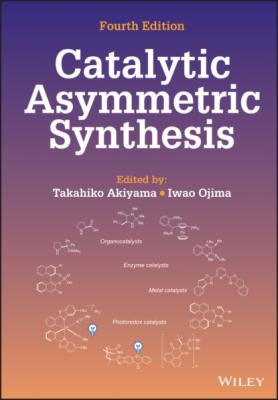Catalytic Asymmetric Synthesis. Группа авторов
Чтение книги онлайн.
Читать онлайн книгу Catalytic Asymmetric Synthesis - Группа авторов страница 31
 is generated predominantly. The development of syn‐selective and enantioselective aldol reactions catalyzed by organocatalyst is a challenging problem. Maruoka developed a biphenyl‐based axially chiral amine with a triflamide moiety (Eq. 1.6). This catalyst is a syn‐selective catalyst and gave excellent enantioselectivity [14].
is generated predominantly. The development of syn‐selective and enantioselective aldol reactions catalyzed by organocatalyst is a challenging problem. Maruoka developed a biphenyl‐based axially chiral amine with a triflamide moiety (Eq. 1.6). This catalyst is a syn‐selective catalyst and gave excellent enantioselectivity [14].
Acetaldehyde is a synthetically useful aldehyde that can act as both a nucleophile and an electrophile. Given its high reactivity, it is difficult to use acetaldehyde as a nucleophile in the aldol reaction even with a metal catalyst. Hayashi developed diarylprolinol, which is an effective catalyst with acetaldehyde as a nucleophile (Eq. 1.7) [15]. This catalyst is also effective in the other cross‐aldol reactions of two different aldehydes [16].
Figure 1.4. Transition state for the aldol reaction catalyzed by proline.
Source: Based on [13].
1.3.2. Mannich Reaction
The Mannich reaction is important for the construction of nitrogen‐containing molecules. List reported the three‐component Mannich reaction of aldehyde, ketone, and anisidine catalyzed by proline in 2000 (Eq. 1.8) [17]. Barbas reported the syn‐selective Mannich reaction of N‐PMP‐protected α‐imino ethyl glyoxylate and an aldehyde, or ketone, in 2002 (Eq. 1.9) [18]. Whereas syn‐selectivity is explained by the model shown in Figure 1.5, the anti‐selective Mannich reaction is a challenging task. Nevertheless, an axially chiral sulfonamide, developed by Maruoka, was successfully used to afford anti‐selective Mannich products [19]. In addition to simple aliphatic aldehydes, an α‐amino acetaldehyde as a nucleophile afforded an anti‐vicinal diamine derivative (Eq. 1.10).
Instead of using a bifunctional catalyst, organocatalysts without an acid moiety, such as diphenylprolinol silyl ether, are effective catalysts in the Mannich reaction to afford the anti‐product selectively with excellent enantioselectivity (Eq. 1.11) [20].
Figure 1.5. Transition state of the Mannich reaction.
1.3.3. Other Functionalization of the α‐Position of Carbonyl Groups
Bifunctional organocatalysts are effective not only for the aldol and Mannich reactions but also for functionalization of the α‐position of carbonyl compounds. α‐Fluorination [21], α‐bromination [22], and α‐iodination [23] of aldehydes are successfully carried out by the use of organocatalyst. Azodicarboxylate is used in the α‐amination of aldehydes catalyzed by proline [24]. α‐Aminoxylation of carbonyls is catalyzed by proline [25] and proline salt [26] using nitrosobenzene as an electrophile. These reactions are summarized in the previous book [6].
1.3.4. Michael Reaction
Organocatalysts are also useful for the addition of carbonyl compounds to electron‐deficient alkenes, known as the Michael reaction. The reaction of aldehydes and nitroalkenes catalyzed by organocatalyst is a well‐investigated reaction. In 2005, diphenylprolinol silyl ether was applied to this reaction, which afforded a Michael product with excellent diastereo‐ and enantioselectivity (Eq. 1.12) [9]. It was also found that an acid additive accelerates the reaction, and the effect of the acid has been investigated in detail (Scheme 1.2) [27]. An enamine and a nitroalkene react to afford cyclobutane A and dihydro‐oxazine N oxide B as initial products, which were converted into the Michael product, and acid affects this conversion step.
As a Michael acceptor, not only nitroalkene but also vinyl sulfones [28], β‐substituted α‐nitroacrylates [29], dicyanoalkenes [30], and β‐substituted α‐cyano α,β‐unsaturated esters [31] can be successfully employed to afford the Michael products with excellent diastereo‐ and enantioselectivity (Eq. 1.13).
Scheme 1.2. The reaction mechanism of the Michael reaction of aldehyde and nitroalkene.
Source: Based on [27].
Low catalyst loading and the development of a reactive catalyst are important issues for the asymmetric synthesis of chiral molecules. For the Michael reaction of aldehydes and nitroalkenes, Wennemers reported a very active tripeptide catalyst H‐D‐Pro‐Pro‐Glu‐NH2, which catalyzes the Michael reaction of butanal and nitrostyrene in the presence of only 0.1 mol% of the catalyst (Eq. 1.14) [32]. This catalyst is a bifunctional catalyst,



